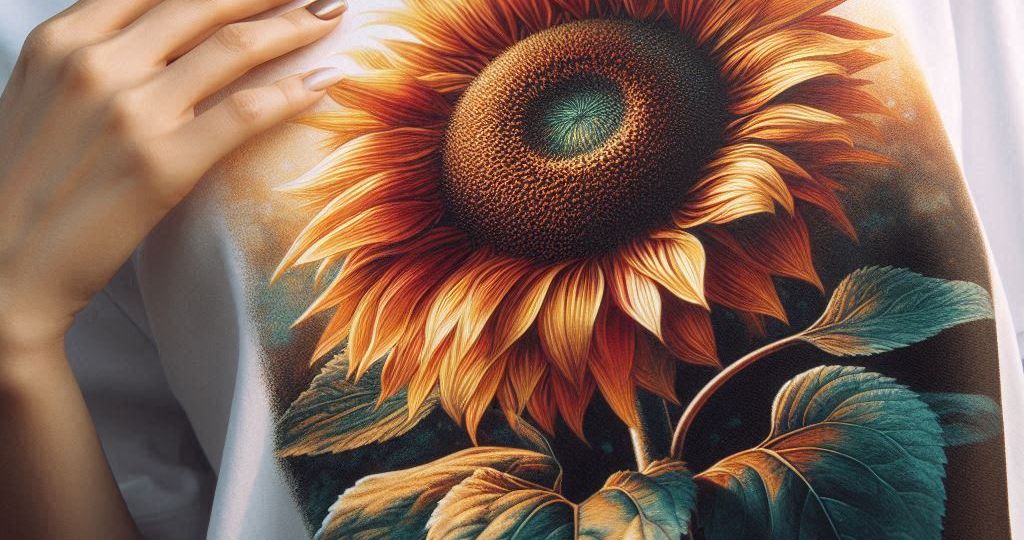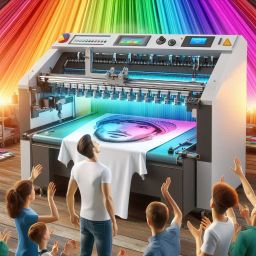

Remember those days of bulky screen printing equipment and large order minimums? Forget that! Direct-to-Film (DTF) printing is changing the game for businesses looking to create custom products.
But what exactly is DTF printing, and why is it becoming a big deal?
Imagine printing designs onto a special film, then easily transferring them to various items! That’s the magic of DTF.
This film is then transferred onto various substrates such as garments, textiles, or promotional items using heat and pressure, resulting in high-quality and durable prints.
Unlike traditional methods, DTF uses inks that stick to a film, which is then heat-pressed onto shirts, hats, bags, and more. It’s like a sticker for your clothes (but way cooler).
Direct to film printing is one such innovation that is revolutionizing the way businesses approach their marketing strategies.
This technology allows for precise and vibrant designs to be printed directly onto a special film, offering a range of benefits for businesses looking to elevate their branding efforts.
In this article, we’ll delve into the importance of DTF printing and how it can make a difference for your business.
Here’s why DTF printing is a hot topic for businesses:
- Print Anything, Anywhere: DTF handles intricate designs, photos, and even text with ease. Unleash your creativity on a variety of materials!
- Small Batch Bliss: Unlike screen printing, DTF allows for small-scale printing. Need just a few custom shirts? No problem!
- Faster Turnarounds: Direct film printing ditches the wait times of screen printing setups. Get high-quality products quickly, perfect for on-demand businesses.
- Eco-Friendly Choice: Direct film printing uses water-based inks and minimizes waste compared to other methods, making it a more sustainable option.
- No Pre-Treatment Hassle: Forget the extra steps! DTF printing works on most materials without pre-treatment, saving you time and effort.
Here are some other benefits of DTF printing for businesses

DTF printing isn’t a one-trick pony! It can be used on a surprising range of materials, from phone cases and sneakers to mugs and keychains.
This opens doors for businesses to create unique and eye-catching products.
- Durable Designs: DTF prints are strong and long-lasting, so your custom products can withstand washing and wear.
- Vibrant Colors: Direct film printing delivers bright, eye-catching colors that make your designs pop.
- Easy Application: The heat transfer process is simple and requires minimal training, allowing businesses to get started quickly.
- Cost-Effective for Short Runs: Compared to screen printing, Direct film printing is more affordable for smaller quantities of custom products.
- Opens Up New Products: Direct film printing works on a wider range of materials than traditional methods, letting you create custom phone cases, hats, bags, and more!
Direct to Film vs. Digital Printing: What You Need to Know
Direct to film (DTF) printing is a popular method for creating custom t-shirts and other apparel. But how does it compare to other digital printing methods? Here’s a breakdown of the pros and cons to help you decide which is best for your needs:
Disadvantages of Direct to Film Printing:
- Limited Material Options: DTF printing works best on fabrics with a high polyester content. Cotton or other natural fibers might not hold the ink as well.
- Durability: DTF prints can crack or peel over time, especially with frequent washing or rough handling. Other digital methods might offer better long-lasting results.
- Setup and Cost: Direct film printing requires specific equipment and inks, which can be more expensive upfront compared to some digital printing methods.
- Color Matching: Matching specific colors exactly can be trickier with DTF printing compared to some digital methods.
Here’s a quick comparison to other digital printing methods:
- Digital Inkjet Printing: Offers excellent detail and wider material compatibility, but may be more expensive for larger quantities.
- Direct to Garment (DTG) Printing: Prints directly on the fabric, good for cotton and other natural fibers, but can be less vibrant on dark colors.
Choosing the Right Printing Method:
The best printing method depends on your project. Consider factors like:
- Material: What type of fabric are you printing on?
- Quantity: How many items do you need printed?
- Durability: How long do you need the prints to last?
- Cost: What’s your budget for printing?
So, who can rock DTF printing?
- Clothing Brands & Designers: Showcase your unique designs on a variety of products without a big upfront investment.
- Merchandise Stores: Offer custom-printed shirts, hats, and bags for your local teams, schools, or events.
- Print-on-Demand Businesses: Create one-of-a-kind designs and sell custom products online with less risk of leftover stock.
- Promotional Products: Print logos, slogans, or event info on a variety of items for impactful marketing campaigns.
Conclusion
DTF printing excels for vibrant designs on polyester garments in smaller batches. But if you need prints on natural fibers, long-lasting results, or a wider material selection, explore other digital printing methods like DTG or inkjet printing.
Remember: Don’t hesitate to consult a printing professional to discuss your options and find the perfect fit for your project!


